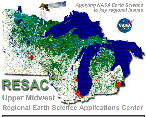
Regional Earth Science Applications Center |
Remote Sensing |

Timely Satellite Data for Agricultural Management |
|
Introduction
Environmentally-sound agriculture increasingly is information-driven. Implementation of new management paradigms such as Integrated Pest Management and Integrated Crop Management requires ready access, by the manager, to environmental data. Satellite-based measurements and the Internet provide two key tools for this access. We are developing management decision aids that derive much of their power from satellite data, made available quickly after collection. By assisting agricultural managers in some daily decisions, pesticide usage is reduced, energy is saved, and potential water quality impacts of crop production are minimized. Upper Midwest Regional Earth Science Applications Center (RESAC)The NASA-funded Upper Midwest RESAC effort involves a consortium of three universities, as well as private sector industry, state government, and educational outreach. The collaboration between agencies within RESAC will spawn constructive product generation and information flow between the educational and research centers, and the private sector.
Real-time Surface Flux Estimates
In additon to polar orbiting and geostationary satellite information, ALEXI model input data fields of temperature, pressure and atmospheric moisture are provided by the CIMSS Regional Assimilation System (CRAS) forecast model. Fraction vegetation cover is provided by the USGS EROS AVHRR 1 km composite, bi-weekly NDVI product. All other radiometric data are from the GOES Sounder instrument. See Mecikalski et al. (1999; J. Appl. Meteor., V. 38, 1352-1369) for more complete details on the analysis technique. Graphics are created with NCAR Graphics.
Decision Support Products in Agriculture
Three decision aids are in various stages of development:
The tools used to develop these decision aids are data sources and research models. The primary data sources are estimates of solar energy at the Earth's surface based on GOES-8 Satellite images and surface weather observations. Two computer simulation models are being used in our work: Mesoscale model of the atmosphere above the United States to provide one and two day forecasts, and a detailed Plant-environment model to assist the development of simple surface models that are interfaced with the mesoscale model to provide site-specific information. TiSDat is part of a NASA-sponsored program to facilitate access to satellite data for all potential users. TiSDat is a suite of decision support information products for agriculture that merge satellite and meteorological data and forecast models of theatmosphere and land surface. Much of the technology is transferable to other crops and applications, and additional products are in development. For technical and administrative background on the program, visit the Public Use of Remote Sensing Data (RSD) page. |
| Updated 18 April 2002 cimssmaster@ssec.wisc.edu |
Space Science and Engineering Center University of Wisconsin-Madison |